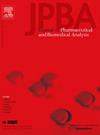A novel quantitative method for the determination of 10B-carrier boronophenylalanine in rat plasma by UHPLC-MS/MS and comparison with ICP-MS
IF 3.1
3区 医学
Q2 CHEMISTRY, ANALYTICAL
Journal of pharmaceutical and biomedical analysis
Pub Date : 2024-10-20
DOI:10.1016/j.jpba.2024.116538
引用次数: 0
Abstract
L-Boronophenylalanine (BPA), a widely used 10B carrier for clinical boron neutron capture therapy (BNCT), was quantified in rat plasma through a simple, effective and stable ultra-high performance liquid chromatography-tandem mass spectrometry (UHPLC-MS/MS) method. Chromatographic separation was performed on an ACQUITY UPLC HSS T3 (100 mm × 2.1 mm, 1.8 μm) column with the mobile phase of 0.5 % formic acid aqueous solution and acetonitrile. For the detector, the m/z ion pairs used for quantification were 209.1→120.1 for BPA and 210.1→120.1 for internal standard in a positive mode by electrospray ionization (ESI) using multiple reaction monitoring (MRM). The method is specific and robust with rare affection by endogenous substances in the matrix. A good linear relationship was observed over 80–80000 ng/mL (r2 = 0.9993). The values of inter- and intra-day accuracy and precision were within the acceptance criteria of ±15 %. BPA was found to be stable under different experimental conditions. This developed method was successfully applied on a pharmacokinetic experiment on Sprague-Dawley rats (intravenous injection, 125 mg/kg) and a comparation between UHPLC-MS/MS and ICP-MS for BPA was carried out.
超高效液相色谱-质谱/质谱法测定大鼠血浆中 10B 载体硼苯丙氨酸的新型定量方法及其与 ICP-MS 的比较。
通过一种简单、有效和稳定的超高效液相色谱-串联质谱(UHPLC-MS/MS)方法对大鼠血浆中广泛应用于临床硼中子俘获疗法(BNCT)的10B载体--L-硼苯丙氨酸(BPA)进行了定量分析。色谱分离采用ACQUITY UPLC HSS T3色谱柱(100 mm × 2.1 mm, 1.8 μm),流动相为0.5%甲酸水溶液和乙腈。检测器为电喷雾离子化(ESI),采用多反应监测(MRM)正离子模式,双酚 A 的 m/z 离子对为 209.1→120.1,内标离子对为 210.1→120.1。该方法特异性强,稳定性好,很少受到基质中内源性物质的影响。在 80-80000 纳克/毫升的范围内观察到良好的线性关系(r2 = 0.9993)。日间和日内的准确度和精密度均在±15%的标准范围内。在不同的实验条件下,双酚 A 的稳定性良好。该方法成功地应用于Sprague-Dawley大鼠的药代动力学实验(静脉注射,125 mg/kg),并进行了UHPLC-MS/MS和ICP-MS测定双酚A的比较。
本文章由计算机程序翻译,如有差异,请以英文原文为准。
求助全文
约1分钟内获得全文
求助全文
来源期刊
CiteScore
6.70
自引率
5.90%
发文量
588
审稿时长
37 days
期刊介绍:
This journal is an international medium directed towards the needs of academic, clinical, government and industrial analysis by publishing original research reports and critical reviews on pharmaceutical and biomedical analysis. It covers the interdisciplinary aspects of analysis in the pharmaceutical, biomedical and clinical sciences, including developments in analytical methodology, instrumentation, computation and interpretation. Submissions on novel applications focusing on drug purity and stability studies, pharmacokinetics, therapeutic monitoring, metabolic profiling; drug-related aspects of analytical biochemistry and forensic toxicology; quality assurance in the pharmaceutical industry are also welcome.
Studies from areas of well established and poorly selective methods, such as UV-VIS spectrophotometry (including derivative and multi-wavelength measurements), basic electroanalytical (potentiometric, polarographic and voltammetric) methods, fluorimetry, flow-injection analysis, etc. are accepted for publication in exceptional cases only, if a unique and substantial advantage over presently known systems is demonstrated. The same applies to the assay of simple drug formulations by any kind of methods and the determination of drugs in biological samples based merely on spiked samples. Drug purity/stability studies should contain information on the structure elucidation of the impurities/degradants.

 求助内容:
求助内容: 应助结果提醒方式:
应助结果提醒方式:


